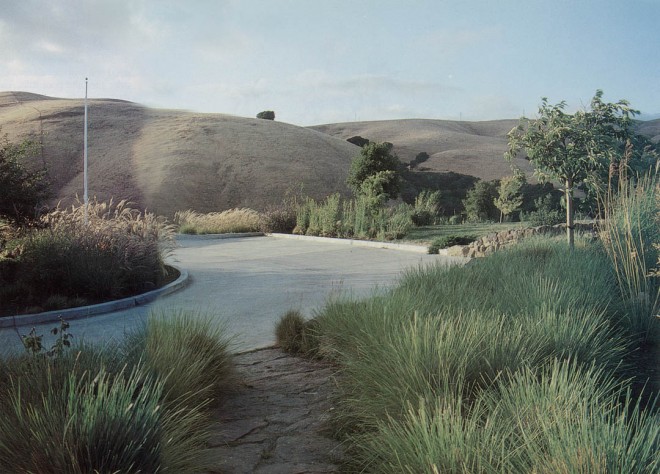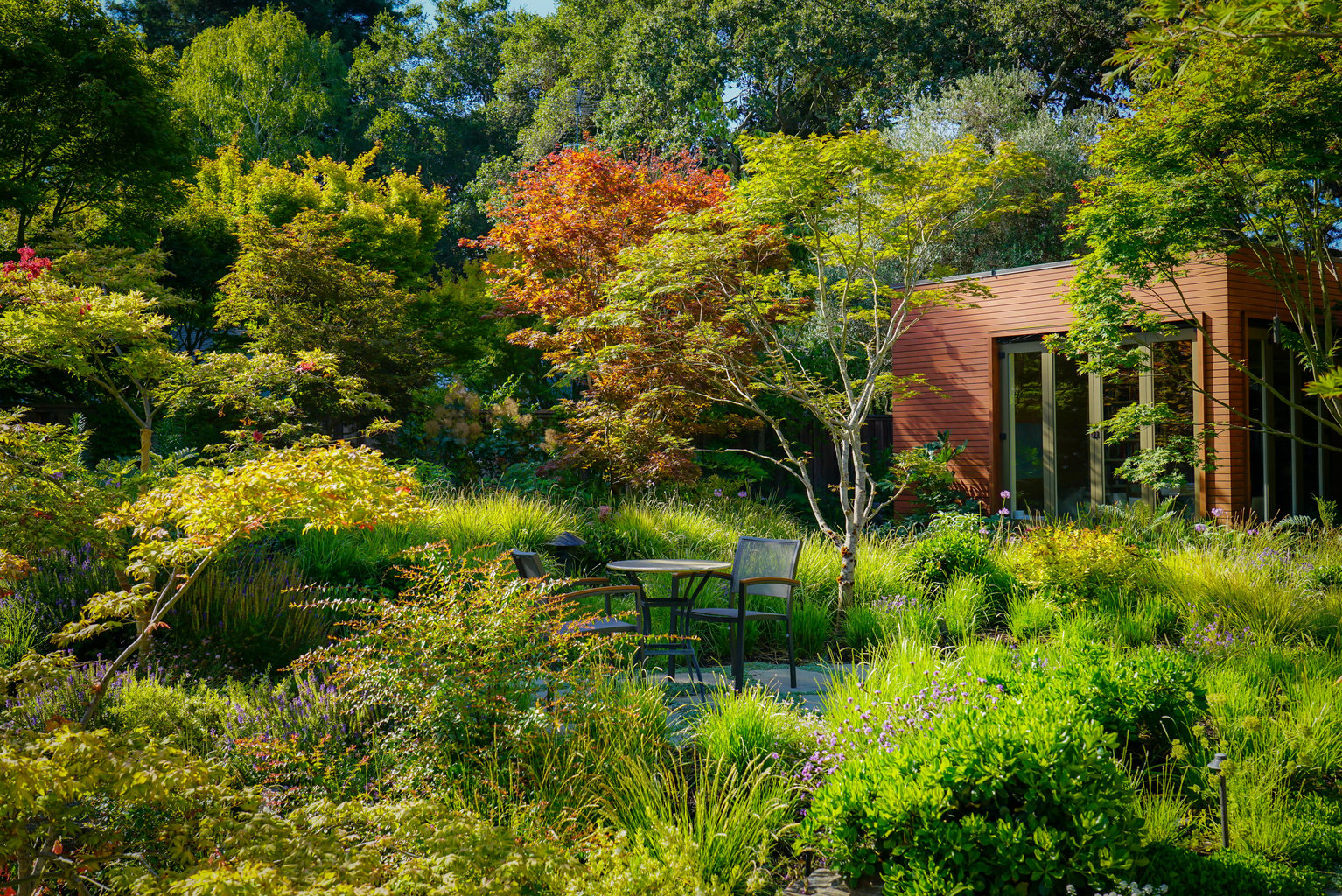

Contributor

It is a grass that provides us with wheat, the most important single food crop in the world… So important is wheat to mankind that about one-fifth of all the cultivated land in the world is devoted to it — about twice as much as is devoted to rice and four times as much as is devoted to barley.
Roger Grounds, Ornamental Grasses
Ornamental grasses, the current rage in East Coast American gardens, have now taken root in the West. Their diversity, utility, grace, and beauty enthrall gardeners from Seattle to San Diego. One of the many roles grasses play in the garden is that of groundcover. Western gardeners have been tempted by luscious photographs of gardens designed by eastern landscape architects Wolfgang Oehme and James van Sweden. Now they are eager to create their own versions of pastoral beauty.
And it is appropriate to do so. Native grasslands once covered vast areas of the West now occupied by cities, suburbs, and farms. Inland valleys and desert highlands alike were once clothed with soft golden grasses. Sadly, far too little of this heritage remains in nature. Ornamental grasses in gardens can help to recapture some of the natural character of the West. Many of the best grasses for groundcovers in western gardens are those that are native to this land.
Success with groundcover grasses requires that consideration be given to the Mediterranean climate of the West. Many of the grasses used extensively in eastern and midwestern gardens struggle in our mild, dry climate, requiring generous watering and cold winters to bloom and thrive. Tall growing warm season grasses, though beautiful, can be a fire hazard. Dormancy periods coinciding with hot seasonal winds make large-scale warm-season grass plantings impractical in urban western gardens.
The best choices for groundcover grasses in the West provide the most green for the least water. Drought tolerant, cool season, evergreen grasses and sedges can create beautiful garden settings. Groundcover grasses are replacing unused, water-loving lawns all over the West. Some groundcover grasses will tolerate mowing and heavy traffic; others survive shade and competition from tree roots. Seven of the best grasses and sedges for groundcovers are described here, beginning with sedges and lawn substitutes.
Sedges and Lawn Substitutes
California meadow sedge (Carex pansa) is native to the West from California to Canada. It makes a fine lawn substitute or unmowed meadow. Growing four to six inches high in good soil with regular water, it stays shorter in drier sites and poor soils. This native sedge has dark green leaves one-sixteenth to one-eighth inch wide and four to eight inches long with a rich, lustrous sheen. Slowly creeping and usually not invasive, California meadow sedge grows well in sun or shade. While it prefers well drained moist soils, it will tolerate a variety of conditions and exposures, including wind, traffic, salt spray, heavy soils, and summer drought. In nature plants are summer dormant. Watering once a week will keep plants evergreen in most situations. California meadow sedge should be planted from plugs or divisions twelve to eighteen inches on center. This sedge is hardy from USDA zones 8 through 10.
Catlin sedge (Carex retroflexa var. texensis) is considered by some landscape designers to be the finest of all lawn substitutes for shade. Named for southern California plantsman and artist Jack Catlin, this low-growing sedge makes a fine groundcover, mowed or not. In spring lax stems hold inconspicuous flowers that lie flat on the foliage. Excellent for shady garden paths or soft, unmowed meadows, Catlin sedge can tolerate kids and dogs alike. It is particularly attractive naturalized with bulbs and flowering perennials. Plant plugs or divisions four to six inches apart for best results. Tolerant of sun and all but deepest shade, Catlin sedge may appear yellowish in hot, arid climates unless planted in light shade. It is solidly hardy to USDA zone 7.
Berkeley sedge (Carex tumulicoIa) was introduced by California native grass expert David Amme of Berkeley, California. It is one of the most versatile of native western sedges, growing from central California to Canada and thriving in hot southern California gardens in both sun and shade. Its tough nature, clumping habit, and dark green color make it a good groundcover for many situations. Leaves one-eighth inch wide and twelve to eighteen inches long arch gracefully from dense clumps. Flowers are noticeable but not showy in spring. Plant from plugs or divisions twelve to eighteen inches apart. When combining with perennials or bulbs, wider spacing may be used. This sedge is tolerant of a wide range of soils and is hardy to USDA zone 8.
Other Groundcover Grasses

Autumn moor grass (Sesleria autumnalis) is a fine choice for a large-scale groundcover. It is distinguished by bright yellow-green foliage and attractive flower spikes. Growing in neat clumps sixteen to eighteen inches high and as wide, this grass has narrow V-shaped leaves one-eighth to one-quarter inch wide topped with flowers that are whitish in spring and tan at maturity. This tough plant is tolerant of conditions ranging from coastal bluffs to inland valleys. Plant autumn moor grass from plugs or divisions twelve to eighteen inches apart. It is hardy from USDA zones 5 through 9.
Sweet vernal grass (Anthoxanthum odoratum) makes a fragrant meadow with its sweetly coumarin-scented leaves. Showy golden flowers top the foliage from early spring through summer. The flowers sway delightfully in the afternoon breeze. Medium green leaves, one-quarter to one-half inch wide, lie mostly flat in soft clumps six to eight inches high and wide. Sweet vernal grass grows best in full sun but fares well in light shade and is tolerant of a wide range of soils and climatic conditions. Plant this grass from plugs or divisions six to eight inches apart. Sweet vernal grass tolerates moderate traffic and occasional mowing and is hardy in USDA zones 5 through 9.
Pacific reed grass (Calamagrostis nutkaensis) is another western native that has proven itself a solid groundcover selection. Glossy green leaves one-half to three-quarters of an inch wide form dense clumps two to three feet high and wide. Tolerant of a great range of soils, it can also withstand wind and coastal conditions. Showy wheat-colored spikes emerge in spring and persist into summer and fall. In hot inland climates it performs best in light shade. Plant Pacific reed grass from plugs or divisions eighteen to twenty-four inches apart. It is hardy in USDA zones 8 and 9.

Atlas fescue (Festuca mairei) is a tough performer from the hot, dry Atlas Mountains of North Africa. Handsome pale gray-green leaves form dense clumps two to three feet tall and wide. Narrow leaves one-eighth to one-quarter inch wide have a glossy sheen that protects against the elements. Flowers are noticeable but not showy in spring. Carefree in most climates, Atlas fescue may develop rust disease in moist coastal gardens, but sunny weather usually cures the affliction. Plant from plugs or divisions spaced two to three feet apart. Hardy in USDA zones 5 through 9.
The groundcover grasses and sedges listed here require little maintenance. All are best cut close to the ground at least once a year, usually in early spring. Flowering grasses and sedges can be tidied up by removing old flower spikes. Lawn substitutes can be mowed as often as desired. Cutting back can be done with hand pruners in small planting areas. Large-scale plantings can be mowed with groundcover mowers or weedeaters with blade attachments. Although grasses and sedges appreciate the usual soil improvements, fertilizers are not required after establishment.
Share:
Social Media
Garden Futurist Podcast
Most Popular
Videos
Topics
Related Posts

Low Maintenance Gardens – Better for Pollinators and People
Autumn 2022 “I come out every day. It’s therapy, my meditation.” Janet’s young garden transformed from overgrown, invasive plants to mostly natives. The dailiness of

Invasive Plants Are Still Being Sold: Preventing Noxious Weeds in Your Landscape
Autumn 2022 With so many beautiful ornamental plant species and cultivars throughout California and the Pacific Northwest, how do you decide which ones to include

Garden Design in Steppe with Transforming Landscapes with Garden Futurist Emmanuel Didier
Summer 2022 Listen to full Garden Futurist: Episode XVII podcast here. Emmanuel Didier, Principal and Creative Director at Didier Design Studio is a leading figure

Seslerias: Versatile Groundcover Meadow Grasses
Summer 2022 Without question, the most beautiful and versatile of all the groundcover meadow grasses are the moor grasses (Sesleria). Moor grasses tick off all









Responses